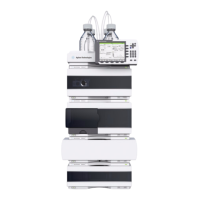Purification Solution - Developer's Guide 63
Calibration Procedures
6
Characterizing the column volume
Characterizing the column volume
Chemicals Both standard analytical system and preparative or combined system:
• Solvent A: water (optionally with 0.1 % formic acid)
• Solvent B: acetonitrile (optionally with 0.1 % formic acid)
• Needle and purge wash solution (degas in ultrasonic bath): 80 % acetonitrile
or another suitable solution
Sample • Thiourea or uracil in 75 % acetonitrile (in water); concentration based on
the UV detector flow cell used. Read the MSDS data sheet for thiourea
before preparing the sample from a powder.
• Recommended: For best column performance and lifetime, filter the sample
before use with a regenerated cellulose syringe filter (5190-5108)
The characterization of the column volume is based on the elution of a
non-retained compound (marker), thiourea or uracil. In the first step, the
column is replaced by a zero-dead-volume connection, and the marker is
eluted using as low a flow as possible with reliable performance. The retention
time in this setup gives the volume of the tubing between the points of
injection and detection. In the second step, the target column is installed and
equilibrated with 75 % acetonitrile. The difference between the retention
volumes of the marker in the setup with and without the column gives the
target column volume. For best results, measure column volumes on a
standard analytical LC system if available.
Characterization of the column volume using thiourea or uracil was optimized
for ZORBAX StableBond C18 columns. A different type of stationary phase
may require adjustment to the solvent composition or a different marker.
Column Volume: Standard Analytical System
1 Prepare a sample vial containing thiourea or uracil at the following
concentration, and place it in the autosampler:

